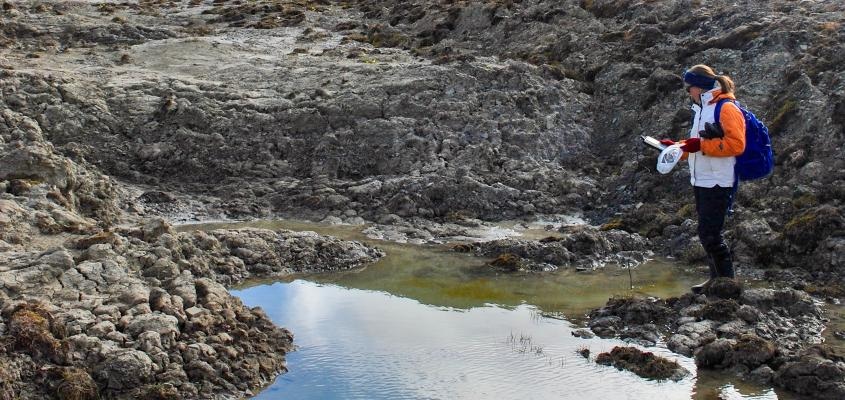Feb 2 2018
Certain ponds in the High Arctic release carbon, which could possibly be a hidden source of greenhouse gas emissions. This was the findings of a new study co-authored by a U of T Scarborough researcher.
 Researcher Gillian Thiel records water samples taken from a pond in the High Arctic near the Cape Bounty Arctic Watershed Observatory. (Image credit: Melissa Lafrenière)
Researcher Gillian Thiel records water samples taken from a pond in the High Arctic near the Cape Bounty Arctic Watershed Observatory. (Image credit: Melissa Lafrenière)
Arctic permafrost – refers to thawing at an accelerated pace owing to climate change – stores dissolved organic carbon (DOC). The new study investigated how this DOC is being released into Arctic watersheds because of physical disturbances, which relocate nutrients across the landscape. Now, for the first time, scientists have successfully established the fact that carbon’s chemical composition in these ponds is considerably different than that found in High Arctic rivers.
These ponds in the High Arctic seem to be hotspots for DOC degradation.
Very little consideration has been given to what’s happening with DOC in these ponds that are all over the Arctic, and it could potentially be a source of CO2 emissions released into the atmosphere with these disturbances.
Myrna Simpson, Co-Author
DOC can be found everywhere – in oceans, lakes, and in soil. It is basically a decomposed animal or plant material that is capable of dissolving by coming into contact with water. In the High Arctic, DOC easily enters into watersheds and thus becomes quite mobile. This is occurring at an accelerated pace as a result of rapid permafrost thaw and the ensuing change in the physical landscape.
“The rapid thawing results in what’s called active layer detachments,” explains Simpson. “Think of these disturbances as landslides where soil and water gets all mixed up.”
When the DOC enters ponds, it can be biodegraded by microorganisms more easily than in rivers, which means more amounts of carbon will be released into the atmosphere. Although previous studies have examined how active layer detachments have triggered the activity of microbes in Arctic soil, this is the first study to look mostly at all water sources, including ponds.
“We didn’t measure how much carbon was being released because we didn’t expect to find this,” says Simpson. “This is one of the novel findings of the study – that these ponds could play an important role in the global carbon cycle.”
What’s more, the Arctic permafrost stores plenty of carbon because it typically remains frozen and locked into place for an extended period of time, noted Simpson. Now, that is changing with rapid thawing of the permafrost. In fact, with the help of radiocarbon dating, the team discovered more than 5,000-year-old DOC that was being degraded.
Queen’s University researchers, Associate Professor Melissa Lafrenière and Professor Scott Lamoureux out of the Cape Bounty Arctic Watershed Observatory near Melville Island in Nunavut performed the sampling of the water sources for the study.
The next major step for the study will be to see how extensive the phenomenon is, for instance, whether it occurs in all Arctic ponds. However, as Lafrenière points out, it is equally crucial to comprehend the underlying mechanisms that drive the vast difference between DOC in ponds versus rivers.
We need to do some mass balance studies to figure out the mass of carbon in these bodies of water. This includes how much carbon is present, and what are the main inputs and outputs controlling how much carbon is in the water.
Myrna Simpson, Co-Author
In order to achieve that, the amount of carbon in the water, as well as the different forms of carbon such as DOC, particulate organic carbon, dissolved inorganic carbon, methane and gaseous CO2 needs to be measured.
Lafrenière added that lab and field experiments in the coming days will be designed to establish the processes that are responsible for gains or losses of carbon from these ponds, as well as the process behind converting carbon from one form to another.
DOC analysis for the study was performed in three different laboratories across Canada so that researchers can use a range of advanced measurements. Professor André Simpson from U of T Scarborough and Professor Yves Gélinas from Concordia University lent their expertise to the research Dr. Jun-Jian Wang, a former postdoctoral fellow in Professor Myrna Simpson’s lab, now an Assistant Professor at the Southern University of Science and Technology in China, collected and compiled the data.
ArcticNet and the Natural Sciences and Engineering Research Council of Canada (NSERC) funded the study, which is featured in the Environmental Science and Technology journal.